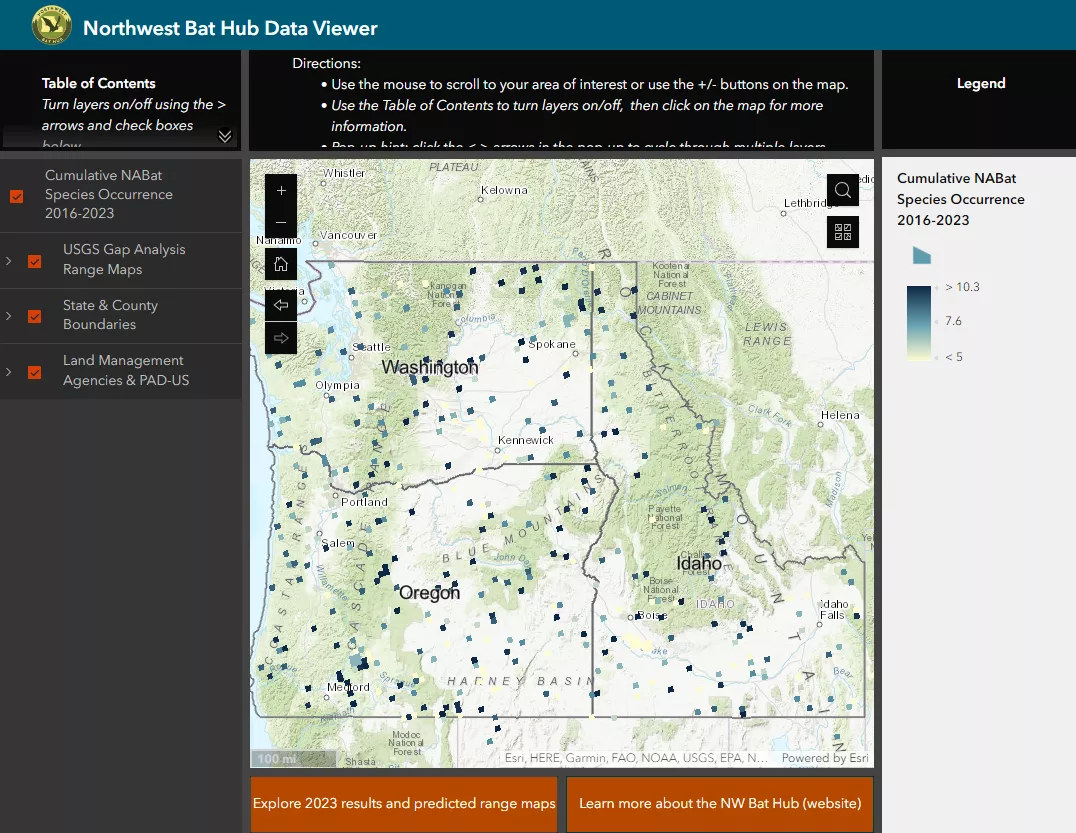The North American Bat Monitoring Program in the Pacific Northwest
The Bat Hub coordinates the NABat monitoring effort in Oregon, Washington, and Idaho by working with state, federal, tribal, and other partners.
The NW Bat Hub Monitoring results viewer has been updated and upgraded!
- This interactive map is a useful tool for those who are looking for detailed lists of bat species composition in a given area in the Pacific Northwest or those who want to follow the results of our collaborative monitoring.
- The data in this tool combines our confirmed acoustic detections with historic range maps and predictive models. Use this viewer to explore findings and extract species lists and other results. For more information about our sources, see below.
Partners
Our collaborative effort brings together several partners including OSU-Cascades, Oregon Department of Fish and Wildlife, U.S. Forest Service, Bureau of Land Management, U.S. Fish and Wildlife Service, U.S. Geological Survey, National Park Service, WA Dept of Fish & Wildlife, ID Fish & Game and volunteers to build off the successes of the original Bat Grid and continue this effort into the future.
The current version of the Pacific Northwest NABat Field Manual can be downloaded here.
The Bat Hub is continually looking for partners who are willing to participate in the state and region-wide monitoring effort. Please email Beth Ward, the Bat Program Coordinator, if you are interested or would like more information.
Did you miss our annual partner meeting?
This year, we covered our 2023 accomplishments, updates predicted occupancy maps for PNW species, and the ever-evolving Audible Bats Project. A recording of the 2024 meeting is available on our new YouTube page. Click here to access the video.

The current version of the Bat Monitoring Data Viewer provides the following layers:
- Expected range: This layer provides a list of species for each grid cell based on best-available range maps.
- Rodhouse, T.J., Ormsbee, P.C., Irvine, K.M., Vierling, L.A., Szewczak, J.M., and Vierling, K.T. 2015. Establishing Conservation Baselines with Dynamic Distribution Models for Bat Populations Facing Imminent Decline. Diversity and Distributions 21.12 (2015): 1401-413. doi:10.1111/ddi.12372
- U.S. Geological Survey – Gap Analysis Project. 2018. U.S.Geological Survey – Gap Analysis Project Species Range Maps CONUS_2001: U.S. Geological Survey data release, doi.org/10.5066/F7Q81B3R
- Rodriguez, R. et al. 2015. Western Bat Working Group. http://wbwg.org/
- California Department of Fish and Wildlife. California Interagency Wildlife Task Group. 2014. CWHR version 9.0 personal computer program. Sacramento, CA.
- Smith, Gregory M., and David L. Waldien. 1999. First Records of Brazilian Free-Tailed Bats (Tadarida Brasiliensis) in the Willamette Valley, Oregon. Northwestern Naturalist 80.3: 113-14. www-jstor-org.ezproxy.proxy.library.oregonstate.edu/stable/3536658
